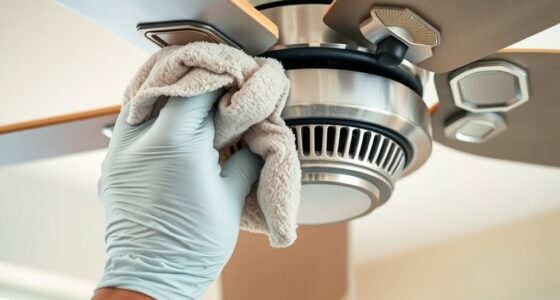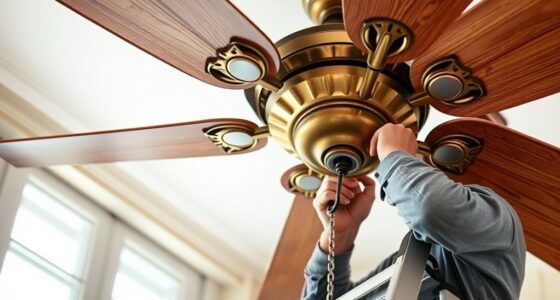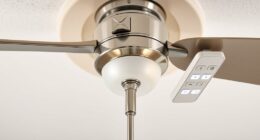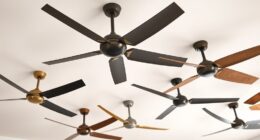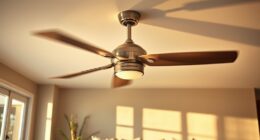To prevent and fix ceiling fan blade sagging, regularly inspect and tighten all mounting hardware, ensuring blades are level with a spirit level. Clean blades with mild detergent to reduce dust and weight buildup, and apply protective coatings to resist environmental damage. If blades sag, carefully straighten or replace warped ones and verify all fasteners are secure. Maintaining a controlled environment and consistent upkeep will prolong blade integrity—continue investigating for detailed solutions.
Key Takeaways
- Regularly inspect and tighten mounting hardware and blade brackets to prevent looseness and sagging.
- Clean blades gently with mild detergent to reduce weight from dust buildup that can cause sagging.
- Use a level to ensure blades are properly aligned and at equal height for balanced operation.
- Replace warped or damaged blades promptly with compatible, new blades to maintain stability.
- Control humidity and environmental factors to minimize material fatigue and warping over time.

Ceiling fan blade sagging is a common issue that can compromise the fan’s stability, efficiency, and safety. When blades begin to droop, it indicates structural deterioration or imbalance that can lead to wobbling, increased noise, and even potential detachment. Addressing this problem promptly is essential to maintain ideal performance and prevent further damage. The root causes of blade sagging typically include material fatigue, accumulated dust and debris, or loosening of mounting hardware over time. Environmental factors such as humidity and temperature fluctuations also accelerate the degradation of blade materials, especially if they are wooden or composite.
Ceiling fan blades sag due to material fatigue, dust, and hardware loosening over time.
To prevent blade sagging, you need to implement regular maintenance routines. Inspect your fan periodically for signs of wear or looseness. Tighten mounting screws and blade brackets securely, ensuring they are free of rust, corrosion, or cracks. Use a level to verify that blades are aligned horizontally; misaligned blades can cause imbalance and contribute to sagging over time. When cleaning blades, avoid harsh chemicals that could weaken the material; instead, use a mild detergent and a soft cloth to remove dust and grime. This reduces weight and prevents buildup that could exert uneven stress on the blades. Additionally, consider applying a protective coating suitable for the blade material to shield against moisture and environmental damage, especially in humid climates. Regular lubrication of moving parts can also help prevent wear that might contribute to blade misalignment or hardware loosening.
If you notice that blades are already sagging, you should act swiftly to correct the issue. Begin by turning off the fan and disconnecting it from power. Remove the blades carefully, inspecting the attachment points for cracks or warping. If the blades are warped, consider replacing them with new ones designed specifically for your fan model. For minor sagging, you can attempt to straighten the blades using gentle, controlled pressure, but this approach requires caution to avoid breakage. When reinstalling, ensure that each blade is mounted at the same height and angle to maintain balance. Use a level to double-check alignment before securing all hardware tightly. Balanced blades reduce wobbling and distribute weight evenly, preventing future sagging.
In cases where hardware components are corroded or damaged beyond repair, replacing mounting brackets, screws, or the entire blade assembly might be necessary. Always use manufacturer-approved parts to ensure compatibility and safety. Proper installation not only restores the fan’s stability but also extends its lifespan. Finally, consider installing a ceiling fan with a blade balancing kit or automated balancing features, which can detect and correct minor imbalances, further reducing the risk of blade sagging. Maintaining a clean and stable environment, such as controlling humidity levels, can also help prolong the life of fan blades and prevent sagging by reducing environmental stress. Consistent maintenance, prompt repairs, and quality replacement parts are essential to keep your ceiling fan functioning safely and efficiently over the long term.
Frequently Asked Questions
How Can I Tell if My Ceiling Fan Blades Are Sagging?
You can tell if your ceiling fan blades are sagging by inspecting their alignment and position. Look for uneven gaps between the blades and the ceiling, or if the blades appear tilted or drooping downward. Use a level to verify if the blades are straight. Sagging blades often cause wobbling or noise when the fan runs. Regular visual checks ensure early detection, preventing further damage or imbalance.
Are There Specific Tools Needed to Fix Blade Sagging?
You’ll need a few essential tools to fix blade sagging effectively. A ladder guarantees safety and proper reach, while a screwdriver is necessary to tighten or replace blade brackets and screws. A small level helps confirm the blades are even, and pliers may be useful for adjusting or removing hardware. For more stubborn issues, a fan blade balancing kit can restore stability. These tools ensure a precise, professional repair.
Can I Prevent Blade Sagging With Regular Maintenance?
Yes, regular maintenance can prevent ceiling fan blade sagging. You should inspect the blades periodically, ensuring they are securely attached and free of dust and debris. Tighten any loose screws or brackets promptly, and balance the blades using a balancing kit if you notice uneven movement. Regular cleaning and inspection help maintain ideal blade alignment, reducing the risk of sagging and prolonging the fan’s lifespan.
What Are the Risks of Ignoring Sagging Blades?
Ignoring sagging blades risks imbalance, which causes excessive vibration and noise, leading to potential motor wear and failure. The uneven weight distribution strains the fan’s mounting, increasing the likelihood of structural damage or detachment. Additionally, persistent imbalance can damage ceiling mounts and compromise safety, posing injury risks. Addressing sagging promptly ensures ideal fan performance, longevity, and safety, preventing costly repairs and maintaining efficient air circulation in your space.
Is It Safe to Repair Ceiling Fan Blades Myself?
Absolutely, you can repair ceiling fan blades yourself if you follow proper safety protocols. First, turn off the power supply and use a sturdy ladder. Wear protective gear, such as gloves and goggles, to prevent injury. Carefully remove the blades, inspect for damage, and reattach or replace as needed. However, if you’re unsure or uncomfortable, consult a professional to avoid risks like electrical shock or falling.
Conclusion
Regularly inspecting your ceiling fan’s blades can prevent sagging and maintain ideal performance. For example, if you notice a blade starting to droop, tightening the mounting screws or adding weight evenly can restore balance. In a case study, a homeowner’s proactive maintenance prevented excessive wobbling and reduced wear on the motor. By following these steps, you guarantee safety, efficiency, and longevity of your fan, avoiding costly repairs and enjoying consistent airflow.


